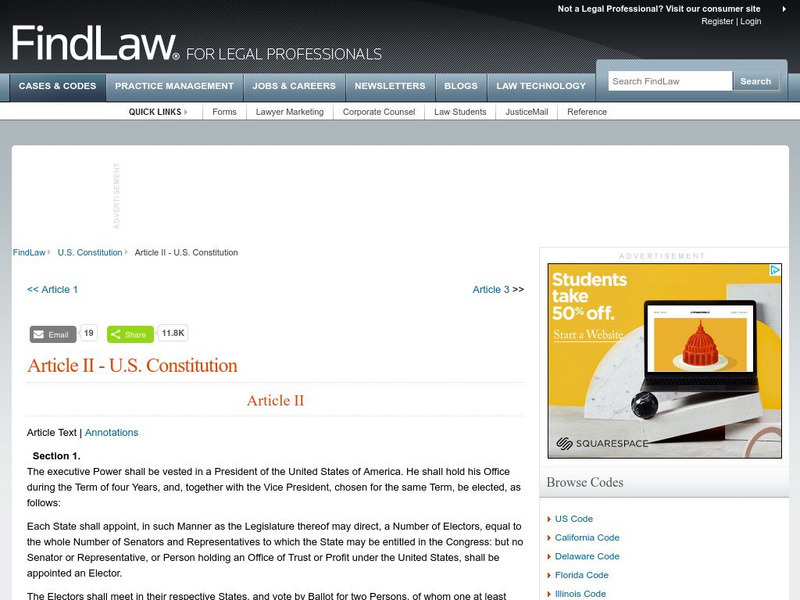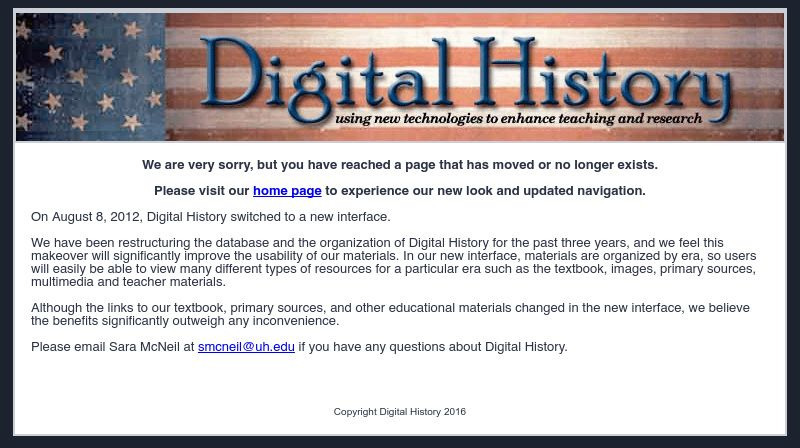iCivics
I Civics: Branches of Power
Do you like running things? Branches of Power allows you to do something that no one else can: control all three branches of government! You'll have the power to write any laws you want about issues you choose. Careful, though, there's a...
A&E Television
History.com: How John Marshall Expanded the Power of the Supreme Court
When John Marshall was appointed chief justice of the U.S. Supreme Court in 1801, the nation's highest court occupied a lowly position. There was no Supreme Court Building in the newly completed capital, Washington, D.C., so the six...
Thomson Reuters
Find Law: Article Ii: Presidential Power to Use Troops
In-depth analysis of the use of presidential power to send troops abroad without consent of Congress.
University of Chicago
The Founders' Constitution: Separation of Powers
Federal Convention on the Separation of Powers as recorded during debate at the convention, June 2, 1787.
Yale University
Avalon Project: Constitution of the United States: Article Ii
Read the text of Article II of the Constitution, the four sections of which lay out the powers and duties of the executive branch of the federal government.
Thomson Reuters
Find Law: United States Constitution: Article Ii
Full text of Article II from the U.S. Constitution, as well as detailed annotations that explain the reasoning and subsequent impact of each clause and section of the Article. Content explores everything from the nature and scope of...
Wikimedia
Wikipedia: President of the United States
This is a comprehensive article on the presidency of the United States. Learn about the history of this office, its responsibilities and its powers.
Annenberg Foundation
Annenberg Learner: Democracy in America: The Modern Presidency: Tools of Power
This unit details how the role of the President of the United States has evolved to the position it is today since the ratification of the U.S. Constitution. Offers video, readings, web resources and activities.
iCivics
I Civics: Games: Branches of Power
Interactive and educational game puts players in control of all three branches of government and tests their abilities to turn issues of concern into full-fledged laws.
iCivics
I Civics: Separation of Powers: What's for Lunch?
Students find out how the three branches of government interact with each other and how decisions about laws are made by several parts of the U.S. government.
Thomson Reuters
Find Law: u.s. Constitution: Article Ii: Powers and Duties of the President
This resource provides the annotation on Section 2, Clause 1 of the United States Constitution., which outlines the President's responsibilities as Commander-in-Chief.
US Mint
United States Mint: Branches of Power
Save the federal government from Oppressor Sam, and learn about the US Constitution to restore the three branches of government.
Center For Civic Education
Center for Civic Education: What Is the Role of the President?
The president has great power granted to him under Article II of the Constitution, while at the same time extensive limits have been placed to keep that power in check. This source contains extensive background on these powers and...
Thomson Reuters
Find Law: Annotation 3: Article I
This resource provides the annotation of Article 1 of the Constitution and the powers held by Congress. Focuses are on the implied, enumerated, inherent, and resulting powers of Congress. At the bottom of the page footnotes are provided.
American Bar Association
American Bar Assoc.: Separation of Powers, Connecting the Separate Powers [Pdf]
This instructional activity involves role-playing to help the students understand the separation of powers. [PDF]
CommonLit
Common Lit: Courage in Denmark: Resistance to the Nazis in Wwii by Us Holocaust
World War II (WWII), a global conflict that lasted from 1939 to 1945 involved more than 100 million people and over 30 countries. The Allied powers - including the United States, the United Kingdom, and the Soviet Union - worked together...
Thomson Reuters
Find Law: Article Ii: The President as a Law Enforcer
Read Section 3 of Article II which explains what the President's duties are as Law Enforcer. The Constitution does not state that the President shall execute the laws himself, but that he will ensure that laws are "faithfully executed."
Harry S. Truman Library and Museum
Harry S. Truman Library & Museum: Three Branches of Government
Interactive teaching unit for Grades 5-8 that helps to explain the three branches of government and the the balance of power. Topics covered include balance of government, how a bill becomes a law, the amendment process, the Legislative...
Other
Tennessee Valley Authority
This is a homepage of The Tennessee Valley Authority (TVA), an independent executive agency of the government.
The White House
The White House: Our Government
Overviews of the major elements of U.S. government, compiled and published by the White House: three branches of the federal government (executive, legislative, judicial), the Constitution, federal agencies and commissions, elections and...
iCivics
I Civics: For the President, All in a Day's Work
Students learn the primary responsibilities of the president and how those duties connect to the powers the Constitution grants to the Executive Branch.
US National Archives
Nara: Teaching With Documents: The Treaty of Guadalupe Hidalgo (Activity)
The National Archives and Records Administration (NARA) provides a lesson plan, focusing on the treaty of Guadalupe Hidalgo, that relates to the power granted to the President and the Senate to make and approve treaties with foreign...
Digital History
Digital History: The Second Red Scare
Senator Joseph McCarthy did not create the national obsession with communist subversion. It had arisen in the late 1930s, years before McCarthy had come to public notice. Angry that they had been barred from the corridors of power for 20...
City College of New York
City Technology: Fantastic Elastic
Explore engineering technology with this unit. Students will study how to design and execute two types of homemade vehicles using elastic.












